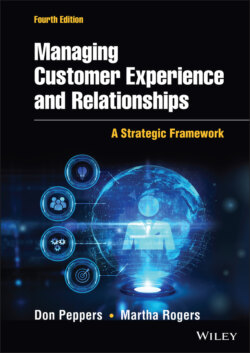Читать книгу Managing Customer Experience and Relationships - Don Peppers - Страница 30
WHAT CHARACTERIZES A RELATIONSHIP?
ОглавлениеMerriam-Webster defines relationship as “the state of being related or interrelated.”8 Because we are talking specifically about relationships between businesses and their customers, it is important that we agree on a few of the elements that make up a genuine relationship. The most important issue for us to consider is how well our own definition of relationship helps companies compete successfully in the customer dimension. Rather than settle for a few words from a dictionary, let's list some of the distinct qualities that should characterize a relationship between an enterprise and a customer.
First, a relationship implies mutuality. In order for any state of affairs to be considered a relationship, both parties have to participate in it and be aware of its existence. This means that relationships will inherently be two-way in nature. This might seem like common sense. You can't have a relationship with someone if they don't have a relationship with you, right? It's a very important distinction for parsing out what does and doesn't constitute relationship-building activity with customers. Can a person have a genuine relationship with a brand? Well, it doesn't happen just because a customer likes the brand and buys it repeatedly. A customer can have a great deal of affection for a brand but, by our definition, a relationship between the customer and the brand can be said to exist only if the brand (i.e., the enterprise behind the brand) is also aware of the individual customer's existence, creating a new definition with an interesting new twist for the term brand awareness.
Second, relationships are driven by interaction. When two parties interact, they exchange information, and this information exchange is a central engine for building on the relationship. Information exchange, of course, also implies mutuality. But interactions don't have to take place by phone or in person or online. An interaction takes place when a customer buys a product. Every interaction increases the amount of information a company has about a particular relationship.
This point leads to the third characteristic of a relationship: It is iterative in nature. That is, mutual interactions between both parties build up a history over time to create a larger context. This increases a relationship's efficiency, because each new interaction is an iteration of all the previous ones. The more you communicate with any one person, the less you need to say the next time around to get your point across. One practical implication of this iterative nature of a customer relationship is that it generates a convenience benefit to the customer for continuing the relationship. Amazon remembers your book preferences, your address, and your credit card number, based on your previous interactions with it. To purchase your next book from Amazon, you only need to find it and click on it. If you've already bought enough books from Amazon, you might not even need to search for the next one; the company can do a pretty good job of finding it for you and putting it in your recommendations. The richer the context of any customer relationship, the more difficult it will be for the customer to recreate it elsewhere, and so the more loyal the customer is likely to be. (We find that Amazon recommends to each of us all of the new books we write—not surprising, since they're all very relevant!)
Another characteristic of a customer relationship is that it is driven by an ongoing benefit to both parties. Convenience is one type of benefit for customers, but it is not the only one. Participating in a relationship will involve a cost in money, time, or effort, and no customer will engage for long in any relationship if there is not enough continuing benefit to offset this cost. However, precisely because of the context of the relationship and its continuing benefit to both parties, each party in a relationship has an incentive to recover from mistakes. This is because the future value that each party expects from the continued relationship can easily outweigh the current cost of remedying an error or problem.
